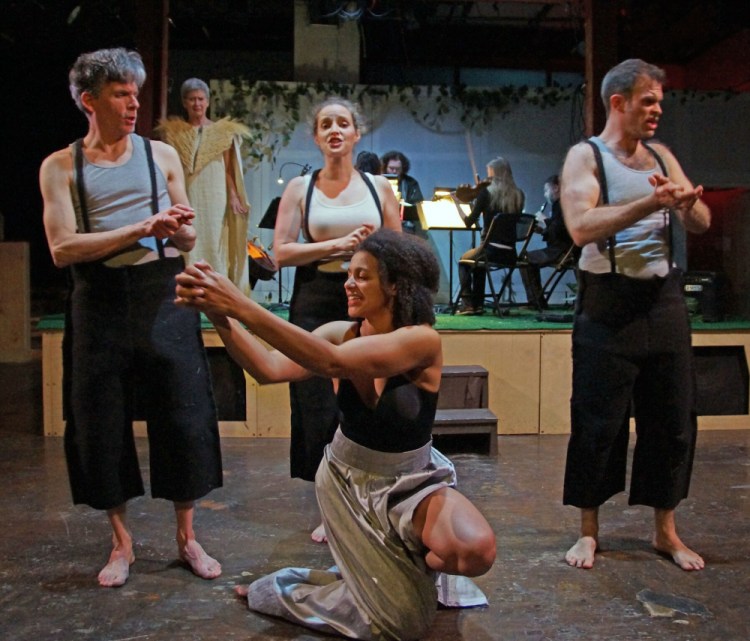Music, poetry, dance, theater and installation art merged in a heady “spoken opera” on Thursday night at the SPACE Gallery in Portland.
The creation of local writer Megan Grumbling and composer Denis Nye, along with a host of collaborators, “Persephone in the Late Anthropocene” re-imagines an ancient Greek myth about a maiden who is drawn into the underworld and the changes that occur upon her return.
Grumbling has tied her variation on the myth to the contemporary era of man-made environmental change, unofficially known as the Anthropocene epoch. Problems, both created by and reflective of Persephone’s actions as she travels between her two worlds, challenge mankind to reach a deeper understanding.
Bridgette Kelly takes the lead role and Deborah Paley her goddess mother, Demeter. A chorus made of Ian Bannon, Paul Haley and Marjolaine Whittlesey assists as the two women dramatically recite Grumblings range of poetry and prose, with dance (no choreographer is credited), to Nye’s music, performed by a three-strings-plus-oboe quartet conducted by Cameron John Prescott.
While the chorus realizes it can “read our own names in her gloom,” Persephone “sings” reflective songs about how humans affect the environment, including through climate change and agricultural impacts, at one point taking the shape of a meal said to “turn shame into starch” with “a milk so sweet it scours.”
Demeter provides narration with a number of “What happened was…” speeches before coming forward to lead a “whodunit” phase where various contemporary culprits are suggested.
The performers established an intimacy to match the relatively small space, with the minimal costumes by Jenna Crowder allowing for close physicality. Whether wrapped up in intentionally uncomfortable-looking contortions or appearing to be controlled by unseen forces, the performers, with an entropic deliberateness that – perhaps inevitably – dragged just a touch at times, established the likely consequences of a world going wrong.
The music occasionally competed for the ears with the spoken word, but it mixed somber impressionism with the darker hues of a stark modernism. An installation by Crowder surrounds the action with leafy sprays and fluorescent wall paintings (lighting by Corey Anderson) to suggest a tenuous nature. And, as if all that weren’t immersive enough, thematic food and drinks by Genevieve Johnson and Nathaniel Meikeljohn were available to premium ticket holders during intermission.
Presented three-quarters in the round by director Tess Van Horn, and with additional elements provided through electronic sound effects and some dry, recorded Farmer’s Almanac factoids, this imaginative work best supports its lament of newly appearing “dead zones” by referencing “the sweetest things gone missing” amid “cold sentences of cannot.”
Steve Feeney is a freelance writer who lives in Portland.
Send questions/comments to the editors.



Success. Please wait for the page to reload. If the page does not reload within 5 seconds, please refresh the page.
Enter your email and password to access comments.
Hi, to comment on stories you must . This profile is in addition to your subscription and website login.
Already have a commenting profile? .
Invalid username/password.
Please check your email to confirm and complete your registration.
Only subscribers are eligible to post comments. Please subscribe or login first for digital access. Here’s why.
Use the form below to reset your password. When you've submitted your account email, we will send an email with a reset code.